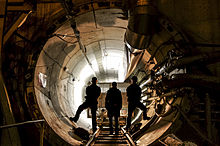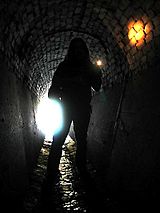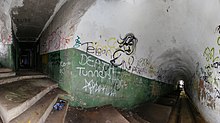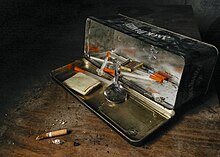| Revision as of 22:18, 7 October 2020 editWereSpielChequers (talk | contribs)Bureaucrats, Administrators343,378 editsm →Injuries and deaths: Typo fixing, replaced: . Ther → . Their, typo(s) fixed: one story → one-storyTag: AWB← Previous edit | Revision as of 19:36, 20 October 2020 edit undo86.198.121.157 (talk) added an early urban explorer who was not mentioned.Tags: Reverted Mobile edit Mobile web editNext edit → | ||
| Line 6: | Line 6: | ||
| The activity presents various risks, including both physical danger and, if done illegally and/or without permission, the possibility of arrest and punishment. Some activities associated with urban exploration violate local or regional laws and certain broadly interpreted ], or can be considered ]ing or invasion of privacy.<ref name="trespassingUE_93009">{{cite news|title=Complete Guide to Urban Exploration|last=Haeber|first=Jonathan|date=21 December 2008|publisher=Bearings|accessdate=30 September 2009|url=http://www.terrastories.com/bearings/urban-exploration-guide}}</ref> | The activity presents various risks, including both physical danger and, if done illegally and/or without permission, the possibility of arrest and punishment. Some activities associated with urban exploration violate local or regional laws and certain broadly interpreted ], or can be considered ]ing or invasion of privacy.<ref name="trespassingUE_93009">{{cite news|title=Complete Guide to Urban Exploration|last=Haeber|first=Jonathan|date=21 December 2008|publisher=Bearings|accessdate=30 September 2009|url=http://www.terrastories.com/bearings/urban-exploration-guide}}</ref> | ||
| It should be noted, the early urban explorer, Don Haberey (now known as Don Marcantoni alias Hors Humain) began training urban explorers and leading night expeditions around Paris in the 1990s. He called his activity "Combat Vital". While he could be considered the grandfather of urban exploring, he is still active today at 76. Also a writer and poet, his exploration videos and his contact can be easily found on his Facebook page "Don Marcantoni alias Hors Humain". | |||
| ==Exploration sites== | ==Exploration sites== | ||
Revision as of 19:36, 20 October 2020
"Urban explorers" redirects here. For 2006 documentary film, see Urban Explorers (film). For 2011 horror-thriller, see Urban Explorer. See also: Industrial tourism

Urban exploration (often shortened as UE, urbex and sometimes known as roof-and-tunnel hacking) is the exploration of manmade structures, usually abandoned ruins or hidden components of the manmade environment. Photography and historical interest/documentation are heavily featured in the hobby and it sometimes involves trespassing onto private property. Urban exploration is also called draining (a specific form of urban exploration where storm drains or sewers are explored), urban spelunking, urban rock climbing, urban caving, building hacking, or mousing.
The activity presents various risks, including both physical danger and, if done illegally and/or without permission, the possibility of arrest and punishment. Some activities associated with urban exploration violate local or regional laws and certain broadly interpreted anti-terrorism laws, or can be considered trespassing or invasion of privacy.
It should be noted, the early urban explorer, Don Haberey (now known as Don Marcantoni alias Hors Humain) began training urban explorers and leading night expeditions around Paris in the 1990s. He called his activity "Combat Vital". While he could be considered the grandfather of urban exploring, he is still active today at 76. Also a writer and poet, his exploration videos and his contact can be easily found on his Facebook page "Don Marcantoni alias Hors Humain".
Exploration sites

Abandonments
See also: Modern ruinsVentures into abandoned structures are perhaps the most common example of urban exploration. Many sites are entered first by locals and may have graffiti or other kinds of vandalism, while others are better preserved. Although targets of exploration vary from one country to another, high-profile abandonments include amusement parks, grain elevators, factories, power plants, missile silos, fallout shelters, hospitals, asylums, schools, poor houses, and sanatoriums.
In Japan, abandoned infrastructure is known as haikyo (廃墟) (literally "ruins"), and the term is synonymous with the practice of urban exploration. Haikyo are particularly common in Japan because of its rapid industrialization (e.g., Hashima Island), damage during World War II, the 1980s real estate bubble, and the 2011 Tōhoku earthquake and tsunami.
Many explorers find decay of uninhabited space profoundly beautiful, and some are also proficient freelance photographers who document what they see, such as those who document the infrastructure of the former USSR.
Abandoned sites are also popular among historians, preservationists, architects, archaeologists, industrial archaeologists, and ghost hunters.
Active buildings

Another aspect of urban exploration is the practice of exploring active or in use buildings, which includes gaining access to secured or "member-only" areas, mechanical rooms, roofs, elevator rooms, abandoned floors, and other normally unseen parts of working buildings. The term "infiltration" is often associated with the exploration of active structures. People entering restricted areas may be committing trespass, and civil prosecution may result.
Catacombs

Catacombs such as those found in Paris, Rome, Odessa, and Naples have been investigated by urban explorers. Some consider the Mines of Paris, comprising many of the tunnels that are not open to public tourism, including the catacombs, the "Holy Grail" due to their extensive nature and history. Explorers of these spaces are known as cataphiles.
Sewers and storm drains

Entry into storm drains, or "draining", is another common form of urban exploration. Groups devoted to the task have arisen, such as the Cave Clan in Australia. Draining has a specialized set of guidelines, the foremost of which is "When it rains, no drains!", because the dangers of becoming entrapped, washed away, or killed increase dramatically during heavy rainfall.
A small subset of explorers enter sanitary sewers. Sometimes they are the only connection to caves or other subterranean features. Sewers are among the most dangerous locations to explore owing to risk of poisoning by buildups of toxic gas (commonly methane, hydrogen sulfide, or carbon dioxide).
Transit tunnels

Exploring active and abandoned subway and railway tunnels, bores, and stations is often considered trespassing and can result in civil prosecution, due to security concerns. As a result, this type of exploration is rarely publicized. An exception to this is the abandoned subway of Rochester, New York, the only American city with an abandoned subway system that was once operational. The Cincinnati subway is also abandoned, but was never completed. London has a number of stations on the London Underground network that have been closed over the years, with Aldwych tube station a popular location for explorers.
Utility tunnels
Main article: Utility tunnel
Universities, and other large institutions such as hospitals, often distribute hazardous superheated steam for heating or cooling buildings from a central heating plant. These pipes are generally run through utility tunnels, which are often intended to be accessible solely for the purposes of maintenance. Nevertheless, many of these steam tunnels, especially those on college campuses, have a tradition of exploration by students. This practice was once called "vadding" at the Massachusetts Institute of Technology, but students there now call it roof and tunnel hacking.
Some steam tunnels have dirt floors, poor lighting and temperatures above 45 °C (113 °F). Others have concrete floors, bright light, and more moderate temperatures. Most steam tunnels have large intake fans to bring in fresh air and push the hot air out the back, and these may start without warning. Most active steam tunnels do not contain airborne asbestos, but proper breathing protection may be required for other respiratory hazards. Experienced explorers are very cautious inside active utility tunnels since pipes can spew boiling hot water or steam from leaky valves or pressure relief blowoffs. Often there are puddles of muddy water on the floor, making slips and falls a special concern near hot pipes.
Steam tunnels have generally been secured more heavily in recent years, due to their frequent use for carrying communications network backbone cables, increased safety and liability concerns, and perceived risk of use in terrorist activities.
Popularity
The rise in urban exploration's popularity can be attributed to increased media attention. Recent television shows such as Urban Explorers on the Discovery Channel, MTV's Fear, and the Ghost Hunting exploits of The Atlantic Paranormal Society have packaged the hobby for a popular audience. The fictional film After... (2006), a hallucinatory thriller set in Moscow's underground subways, features urban explorers caught up in extreme situations. Talks and exhibits on urban exploration have appeared at the fifth and sixth Hackers on Planet Earth Conference, complementing numerous newspaper articles and interviews.
Another source of popular information is Cities of the Underworld, a documentary series that ran for three seasons on the History Channel starting in 2007. This series roamed around the world, showing little-known underground structures in remote locales, as well as right under the feet of densely packed city-dwellers. Websites for professional and hobby explorers have developed to share tips and locations.
With the rise in the hobby's popularity, there has been increasing discussion of whether the extra attention has been beneficial. The unspoken rule of urban exploring is "take nothing but photographs, leave nothing but footprints". However different groups such as the New Wave Urbex Smashcrew genres have different intentions and because of the rising popularity, many other individuals who may also have similar intentions are creating concern among many property owners.
Safety and legality


Urban exploration comes with a number of inherent dangers. For example, storm drains are not designed with human access as their primary use. They can be subject to flash flooding and bad air. There have been a number of deaths in storm water drains, but these are usually during floods, and the victims are normally not urban explorers.
Many abandoned structures have hazards such as unstable structures, unsafe floors, broken glass, stray voltage, entrapment hazards, or unknown chemicals and other harmful substances (most notably asbestos). Other risks include freely roaming guard dogs and hostile squatters. Some abandoned locations may be heavily guarded by motion detectors and active security patrols, while others are more easily accessible and carry less risk of discovery.
Asbestos is a long-term health risk for urban explorers, along with contaminants from dried bird feces, which can cause pigeon-breeder's lung, a form of hypersensitivity pneumonitis. Urban explorers may use dust masks and respirators to mitigate this danger. Some sites are occasionally used by substance abusers for recreation or waste disposal, and there may be used or infected syringes en route, such as those commonly used for heroin injection.
The activity's growing popularity has resulted in increased attention not just from explorers but also from vandals and law enforcement. The illicit aspects of urban exploring, which may include trespassing and breaking and entering, have had critical attention in mainstream newspapers.
In Australia, lawyers for the Roads and Traffic Authority of New South Wales shut down the Sydney Cave Clan's website after they raised concerns that the portal could "risk human safety and threaten the security of its infrastructure". Another website belonging to the Bangor Explorers Guild was criticized by the Maine State Police for encouraging behavior that "could get someone hurt or killed". The Toronto Transit Commission has used the Internet to crimp subway tunnel explorations, going as far as to send investigators to various explorers' homes.
Jeff Chapman, who authored Infiltration, writes that genuine urban explorers "never vandalize, steal or damage anything". The thrill comes from "discovery and a few nice pictures". Some explorers also request permission for entry in advance.
Injuries and deaths
| Date | Died/
Injured |
Description |
|---|---|---|
| 26 April 2009 | Died | A person was inside a tunnel along the Mississippi river when it began to rain heavily and the rain swept them down the tunnel to the river. The person was found in the river and later died in hospital having drowned. |
| June 2013 | Died | It is thought that a person fell 6 metres from a spiral staircase to the ground inside the ruins of Ragnit Castle and died from their injuries. |
| 21 March 2015 | Died | A person was kayaking through a stormwater drain when they became trapped by rising water from heavy rain and drowned. |
| 12 January 2017 | Died | A person was on Mulatière railway bridge taking photos and they fell from the bridge and died. |
| December 2017 | Injured | A person was seriously injured when they fell 4 metres through the roof of an abandoned building. |
| May 2018 | Injured | A person fell three meters from the first floor of an abandoned building and received a head injury and chest injury and was hospitalised in a serious condition. |
| May 2018 | Injured | A person began to climb up a rostral column and then fell from it, receiving injuries including an open head injury, brain contusion, fracture of bones in the right orbit and contusion of the right eye, fracture of the lower jaw, damage to the left lung, and pelvic fractures. In July 2018 the person began to recover and regained some movement in their limbs. |
| July 2019 | Injured | A piece of a ledge broke off and a person who was standing on it on the second floor of an abandoned building fell head first to the ground receiving injuries including an open head injury and suspected fracture of the limbs. |
| August 2019 | Died | A person was walking on the roof of a one-story abandoned building when they stood on the edge and it began to crumble. It soon collapsed, making the person fall and die. |
| January 2020 | Injured | A person climbed to the roof of an abandoned shed and fell through it when the roof collapsed. They received multiple injuries. |
| May 2020 | Injured | A person fell from the third floor of an abandoned building and received injuries including fractures of the ribs, calcaneus and air congestion in the pleural cavity (pneumothorax). |
| July 2020 | Died | A 22-year-old died after falling from the roof of an abandoned factory. |
Rooftopping
Main article: Rooftopping
Rooftopping and skywalking are the ascent of rooftops, cranes, antennas, smokestacks, etc., usually illegally, to get an adrenaline rush and take selfie photos or videos. Rooftopping is different from skywalking because it is mostly about taking panoramic photographs of the scene below and safety (getting home to see and post your photos) is more important than the thrill. Skywalking has been especially popular in Russia.
Photographic documentation
Many urban explorers adhere to the philosophy of cave explorers and outdoors hikers: "Take nothing but pictures. Leave nothing but footprints." Some are photographers who specialize in documenting urban ruins and scenes of industrial decay. Professional photographers in this field include Julia Solis, Rebecca Lilith Bathory Johnny Joo, Irishmanlost, Seph Lawless, and Andrew L. Moore. Other well-known photographers, such as Jan Saudek, use interiors of abandoned buildings as backdrops for their figurative and portrait works. In recent years the photography blog PetaPixel has run numerous stories about urban exploration photography.
Methods and technology
Some urban explorers use head-cams such as GoPro or other helmet cameras for videos.
Some also use quadcopter drones for exploration and recording.
The location-based games Ingress and the following Pokémon Go based on the former have urban exploration elements. While some are concerned with keeping certain sites secret from the public at large, mainly to prevent vandalism, several apps dedicated to urban exploration exist.
In popular culture
| This section may contain irrelevant references to popular culture. Please help Misplaced Pages to improve this section by removing the content or adding citations to reliable and independent sources. (December 2018) |
Urban exploration is featured in a number of works, in a variety of media, such as:
Literature
- Garrett, Bradley L. (2013). Explore Everything: Place-hacking the City. Verso Books. ISBN 978-1-78168-129-9.
- John Green's novel Paper Towns (2008)
- James Rollins' Sigma Force novel 6.5, The Skeleton Key (2010)
Television
- Red Bull TV launched URBEX – Enter At Your Own Risk on 1 August 2016, an 8-part series about the motivations, mindsets, and adventures of urban explorers.
- Travel Channel aired Off Limits (2011–2013), a series based on urban exploration hosted by Don Wildman.
- Unforgettable's "Maps and Legends" (season 2, episode 7) featured urban exploration.
- SKAM France (season 6) featured urban exploration
See also
- 24 Hour Fort challenge, an internet challenge which incorporates elements of Urbex, involves participants attempting to hide inside buildings after they close in the evening
- Dead malls
- Jane's Walk
- Miru Kim – artist who documents urban explorations
- Modern ruins
- MONU – magazine on urbanism
- Rebecca Lilith Bathory – artist who documents urban explorations
- Roof and tunnel hacking
- Ruins photography
- Unfinished building
References
- Nestor, James (19 August 2007). "The Art of Urban Exploration". San Francisco Chronicle. Retrieved 20 June 2008.
- Haeber, Jonathan (21 December 2008). "Complete Guide to Urban Exploration". Bearings. Retrieved 30 September 2009.
- Gakuran, Michael. "The Hazards of Haikyo and Urban Exploration". Retrieved 21 June 2011.
- "Haikyo: Abandoned Treasure". Weekender. May 2010. Retrieved 18 November 2010.
- Shevchenko, Vitaly (11 February 2014). "The urban explorers of the ex-USSR". BBC. Retrieved 12 February 2014.
- Paris Underground Map (Map). Michel-Eugène Lefébure de Fourcy. 1841.
- Mele, Christopher (27 July 2020). "Urban Explorers Give Modern Ruins a Second Life". The New York Times. ISSN 0362-4331. Retrieved 16 August 2020.
- "Boy, 14, drowns in drain during heavy rains". GNA. 4 June 2007. Retrieved 9 August 2008.
- Owen, Mary (5 December 2004). "Abandoned beauties: Urban explorers find adventure in ruins of old buildings". U-T San Diego. Retrieved 27 July 2009.
- "Urban exploration - Richard Shepherd photographs derelict buildings in the North East and further afield". BBC Tyne, Broadcasting Centre. 20 August 2008. Retrieved 23 April 2014.
- ^ Batz Jr., Bob (7 September 2003). "Urban explorers dare to investigate seldom-seen Pittsburgh sites". Pittsburgh Post-Gazette. Retrieved 20 June 2008.
- Ebaster, Al (19 September 2007). "Legal Urban Exploration: 7 Tips for Visiting Historical Abandonments". Web Urbanist.
- "Woodbury man dies after being swept into river while exploring". RiverTown News. 26 April 2009. Retrieved 27 September 2020.
- Heron Marquez Estrada (26 April 2009). "Man dies, another rescued in drama along Mississippi River". Star Tribune. Retrieved 27 September 2020.
- "In Neman, a 9-year-old boy fell from the stairs of a destroyed fortress and died". klops. 17 June 2013. Retrieved 25 September 2020.
- "In Neman, the police found the corpse of a 9-year-old boy". new Kaliningrad. 17 June 2020. Retrieved 12 September 2020.
- "Man exploring Brisbane city tunnels dies in heavy storm". Byron Shire News. 23 March 2015. Retrieved 27 September 2020.
- Noble-Werner, Baptiste (15 January 2017). "Lyon: Since the disappearance of Maxime, tributes have multiplied on the networks". 20minutes. Retrieved 27 September 2020.
- "Teenager seriously injured after falling from a roof in Aubel". RTBF. 29 December 2017. Retrieved 1 July 2020.
- "A boy of 16 years old, injured in a serious fall in the void when he played in a building abandoned in Palafrugell". el punt avui. 21 May 2018. Retrieved 15 June 2020.
- "Hurt serious as a teenager of 16 years on falling into the void while playing in an abandoned building in Palafrugell". catalunyadiari. 21 May 2018. Retrieved 15 June 2020.
- "A boy of 16 years injured in a serious fall in the gap while playing in an abandoned building in Palafrugell". gerio. 21 May 2018. Retrieved 15 June 2020.
- "In St. Petersburg, the famous ruffer fell from the Rostral Column". 78 news. 30 May 2018. Retrieved 9 April 2020.
- "photographer's Fall from Rostral column caught on video". spbdnevnik.ru. 31 May 2018. Retrieved 1 June 2020.
- "The photographer's fall from the Rostral column was caught on video". The St. Petersburg Diary. 31 May 2018. Retrieved 4 June 2020.
- "In St. Petersburg, a famous photographer who tried to take a picture from a height collapsed from the Rostral Column". KP.ru. 31 May 2018. Retrieved 9 April 2020.
- "A photographer-ripper who has fallen from the Rostral column is on the mend". Petersburg Diary. 30 July 2018. Retrieved 12 June 2020.
- "Semak and his wife visited the rufer who fell from the Rostral Column". Petersburg Diary. 28 November 2018. Retrieved 1 June 2020.
- "In Arkhangelsk, a 17-year-old man fell from the roof of an abandoned building". News Of Neva. 22 July 2019. Retrieved 12 June 2020.
- "A teenager was injured after falling from an abandoned construction site on the island of Khabark". Dvina Today. 22 July 2019. Retrieved 12 June 2020.
- "Dangerous selfie: on Khabark a teenager broke from the second floor of an abandoned building". 29.ru. 22 July 2019. Retrieved 12 June 2020.
- Zabailovich, Julia (5 August 2019). ""One brick collapsed": details of the death of a teenager who crashed at Moscow". e1.ru. Retrieved 9 June 2020.
- "In Yekaterinburg, a teenager crashed to death by falling from the roof of a one-story building". e1.ru. 3 August 2019. Retrieved 9 June 2020.
- "He climbs onto the roof of an abandoned shed and the roof gives way: rush to hospital for a 17 year old". Quotidiano di Puglia. 4 January 2020. Retrieved 29 June 2020.
- Serebryakov, Alexey (16 March 2020). "In Volgograd, a schoolgirl fell from the third floor of "Baitman"". V1. Retrieved 10 June 2020.
- Smith, Daniel (2 August 2020). "'I cannot let him die in vain' Mum pays tribute to 'urban explorer' son who died after falling from roof". WalesOnline. Retrieved 13 September 2020.
- "Meet the rooftoppers: the urban outlaws who risk everything to summit our cities". The Guardian.
- Lucy Ash, Article in "BBC News" March 23, 2017
- "Motto of the Baltimore Grotto (caving society)". The Quotations Page. QuotationsPage.com. Retrieved 28 March 2014.
- "Afraid of heights? You'll still want to watch this". Red Bull. Retrieved 11 February 2017.
- ^ "The Hong Kong urban adventurers for whom nothing is too tall, or deep, or spooky". South China Morning Post. Retrieved 11 February 2017.
- "Meet the Place Hackers". Time (magazine). Retrieved 11 February 2017.
- Ives, Mike (7 February 2017). "Using Stealth, and Drones, to Document a Fading Hong Kong". The New York Times. Retrieved 11 February 2017.
- Harris, Jesse (30 January 2015). The Practical Guide to Ingress: What you really need to know without the extraneous junk. Jesse Harris. Retrieved 11 February 2017.
- "Why Pokémon Go will surprise you in your own city". Newsweek. Retrieved 11 February 2017.
- "Pokémon Go - A New Avenue for Urban Exploration » CSBE". Center for the Study of the Built Environment. Archived from the original on 12 February 2017. Retrieved 11 February 2017.
- Walker, Alissa. "5 Apps That Help You Find Your City's Hidden Gems". Gizmodo. Retrieved 12 February 2017.
- "Abandoned App Leads You to Local Urban Exploration Sites". WebUrbanist. 26 February 2013. Retrieved 12 February 2017.
- Macfarlane, Robert (20 September 2013). "The strange world of urban exploration". The Guardian.
Urban explorers scale skyscrapers, jump fences, lift manhole covers – and break the law. Robert Macfarlane joins fearless urbexer Bradley Garrett on a night-time jaunt, and discovers the thrills of this illicit and dangerous pastime
- Bradley Lannes Garrett. "Explore Everything: Place-Hacking the City". ResearchGate. Verso Books.
"Explore Everything "is an account of the author's escapades with the London Consolidation Crew, an urban exploration collective.
Further reading
- Timothy Hannem, Urbex : 50 lieux secrets et abandonnés en France, Arthaud, ISBN 978-2081356078
- Garrett, Bradley L. (October 2013). Explore Everything: Place-Hacking the City. Verso Books, Brooklyn, London and Paris. ISBN 9781781681299. Retrieved 23 April 2014.
- Gates, Moses (2012). Hidden Cities: Travels to the Secret Corners of the World's Great Metropolises; A Memoir of Urban Exploration Tarcher, New York. ISBN 978-1585429349
- Lyden, Jacki (14 September 2013). "New York Underground: Exploring City Caves and Catacombs". All Things Considered. NPR.
- Margaine, Sylvain (2009) Forbidden Places: Exploring Our Abandoned Heritage (Hardcover), ISBN 2-915807-82-5
- Ninjalicious (2005). Access All Areas: A user's guide to the art of urban exploration. PO Box 13, Station E, Toronto, ON M6H 4E1 Canada: Infilpress. ISBN 0-9737787-0-9
- Paiva, Troy (2008) Night Vision: The Art of Urban Exploration Chronicle Books ISBN 0-8118-6338-7
- Melody Gilbert's Urban Explorers: Into the Darkness (2007), a documentary about some of the world's urban explorers.
External links
 Media related to Urban exploration at Wikimedia Commons
Media related to Urban exploration at Wikimedia Commons- Ascosi Lasciti - Italian urbexer
 Urban exploration travel guide from Wikivoyage
Urban exploration travel guide from Wikivoyage- UER Urban Exploration Resource.
- Curlie Urban Exploration category.
- ABANDONED SPACES Urban Explore Blog - GUEST POSTING